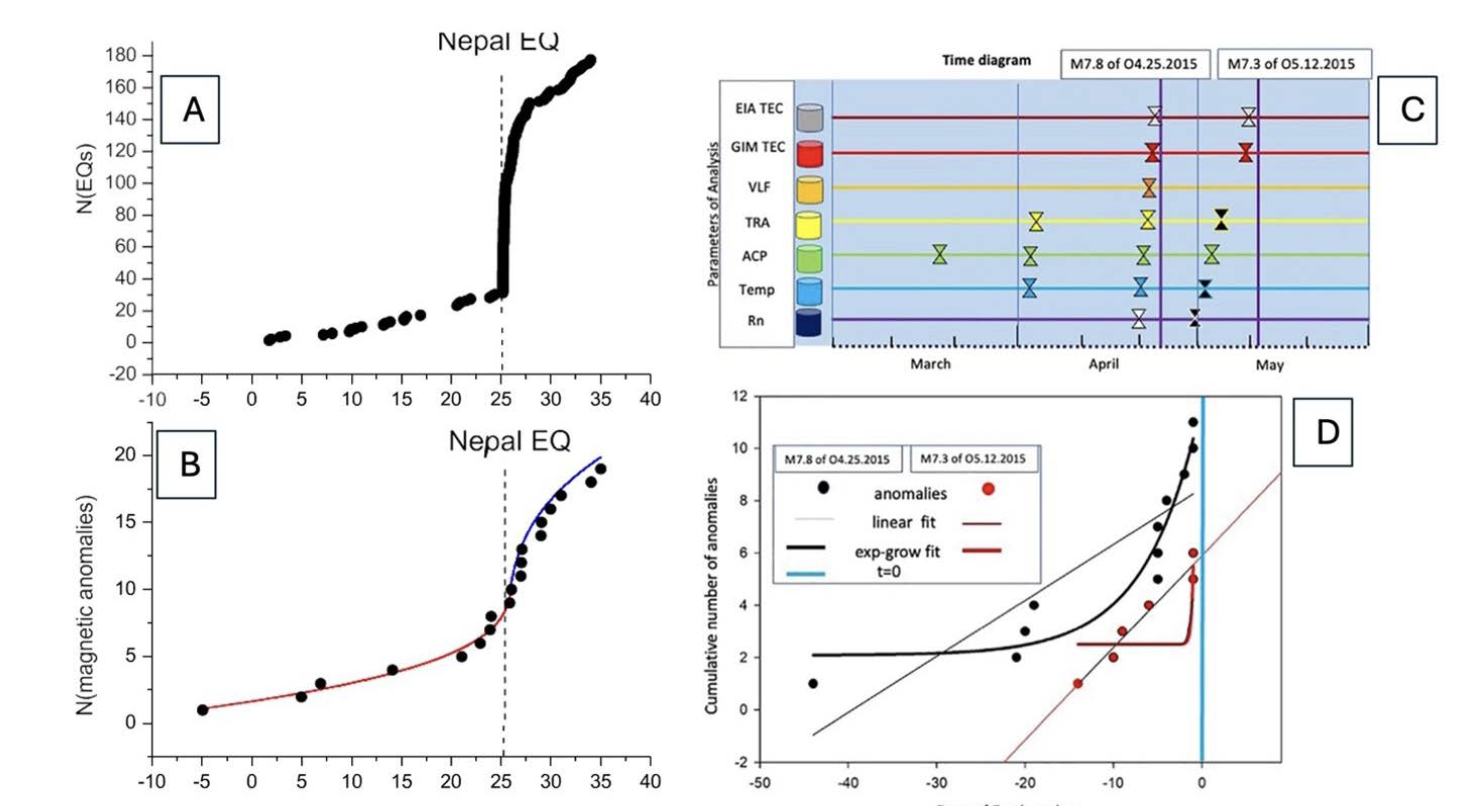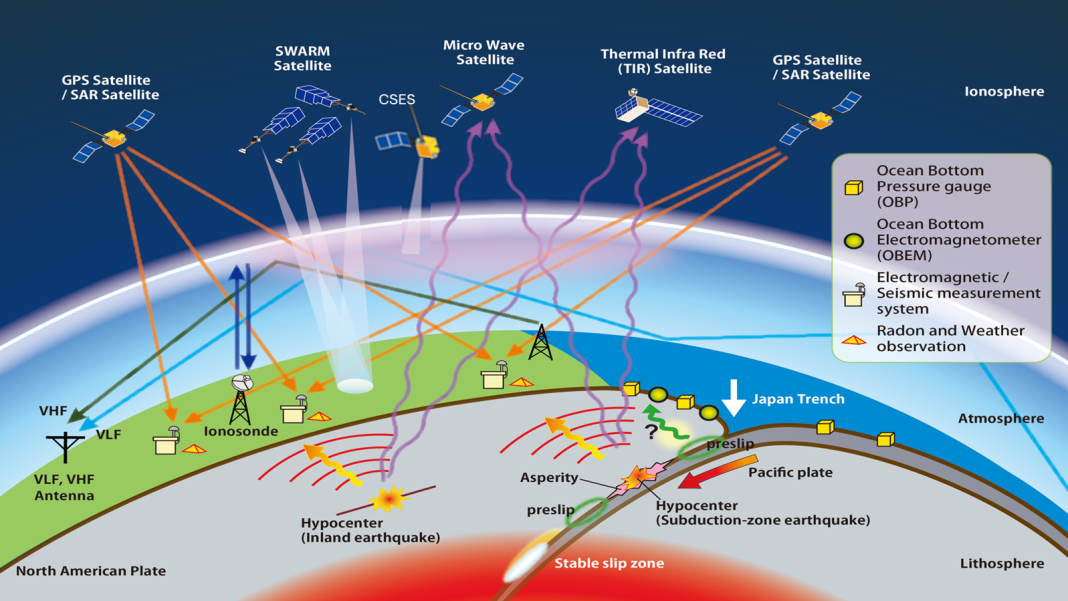Dr. Dimitar Ouzounov from the Institute for Earth, Computing, Human, and Observing (Institute for ECHO) at Chapman University and Dr. Angelo De Santis from the National Institute of Geophysics and Volcanology (Rome, Italy) are exploring new technologies for short-term earthquake forecasting and prediction, including the application of the LAIC approach to the 2015 Gorkha earthquakes in Nepal
Dimitar Ouzounov, Angelo De Santis
As we approach the 10th anniversary of the Gorkha earthquakes in Nepal – M7.8 on April 25 and M7.3 on May 12, 2015, the international scientific community is still actively seeking solutions for the early detection of major seismic events to minimize human loss. Such mega disasters could claim thousands of lives and cause extensive economic losses – about 8,800 people lost their lives – and the overall damage is estimated to be between $5 billion and $10 billion, a significant portion of Nepal’s gross domestic product (GDP) of $19.2 billion.

1. Lithosphere-atmosphere-ionosphere coupling (LAIC)
The lithosphere-atmosphere-ionosphere coupling (LAIC) model explains the synergy among various Earth’s surface, atmospheric, and ionospheric processes and the anomalous variations observed before significant earthquake occurrences. The reporting of physical phenomena before large earthquakes has a long history. Fog, clouds, and animal behaviour have been recorded since the days of Aristotle in Ancient Greece, Pliny in Ancient Rome, and numerous scholars in ancient China.
Unsurprisingly, a significant accumulation of stress in the Earth’s crust can produce precursory signals.
Earth observations from sensors in space and on the ground present new opportunities for investigating stress build-up within the Earth’s crust before earthquakes and monitoring a wide range of abnormal phenomena that may be linked. By examining potential lithosphere-atmosphere coupling, we could enhance our understanding of the events leading up to earthquakes on a global scale.
The first contribution to the current LAIC framework was proposed in the late 1990s. New satellite observations of ionospheric plasma, ground electromagnetic fields, and radon observations provided valuable data suggesting a possible connection with major seismic activity (Pulinets and Boyarchuk 2004).
Over the years, it has been recognized that the coupling between the lithosphere, atmosphere, ionosphere, and magnetosphere is a universal property of our environment and characterizes many natural processes, including earthquakes and other phenomena related to air ionization.
2. The takeaways from the Nepal 2015 earthquakes
Using measurements from the Swarm magnetic satellites, we investigated the potential for detecting a series of anomalous magnetic signals linked to the 2015 M7.8 and M7.3 Nepal earthquakes (De Santis et al., 2017). This may be due to LAIC, which could indicate a possible precursory pattern for earthquakes. Various techniques were applied to the Swarm data available during the two months surrounding the earthquakes’ occurrence.
From the series of magnetic anomalies detected at night and during magnetically quiet periods, we show that the cumulative number of anomalies exhibits the typical power- law behaviour of a critical system as it approaches its critical time and then recovers in a manner consistent with the usual recovery phase following a significant event, with an overall pattern resembling an S-shape. We propose that these anomalies may be linked to the preparation phase of the Nepal earthquake.
We enhanced this study by analyzing transient variations of six different physical parameters in the atmosphere and ionosphere, both retrospectively for the 2015 M7.8 and prospectively for the M7.3 earthquakes in Nepal (Ouzounov et al., 2021).
Our results demonstrate coherence between the occurrence of these pre-earthquake transient effects in the atmosphere and ionosphere (with a short time lag, ranging from hours to a few days) and the M7.8 and M7.3 events of 2015. The spatial characteristics of the pre-earthquake anomalies were associated with a large area but remained within the preparation region that scales with earthquake magnitude, as estimated by the Dobrovolsky- Bowman formula.
The nature of the atmospheric and ionospheric signals was revealed through simultaneous analysis of satellite data, GPS/TEC, and VLF/LF, suggesting that they follow a general temporal-spatial evolution pattern observed in other large earthquakes worldwide.
Detecting multiple precursory earthquake signals and new evidence from space and ground observations have provided crucial insights into the existence of pre-earthquake processes, underscoring the significance of our research.

of the earthquake. The direction of satellite movement is indicated by a black arrow, with the upward direction represented by an arrow pointing upwards (ascending) and the downward direction represented by an arrow pointing downwards (descending). In this case, the orbit is descending. The red point depicts another M5+ earthquake occurring in the same spatio-temporal interval (Alimoradi et al., 2025). (B) Thermal Radiation anomaly observed from NOAA/AVHRR on May 2, 2015, in the vicinity of the M7.3 epicenter of May 12, 2015. Tectonic plate boundaries are indicated with red lines, major faults with brown ones (Ouzounov et al., 2021).
3. The potential of LAIC and pre-earthquake signals for short-time prediction/ forecasting
The complexity of the earthquake generation process limits scientific knowledge and results in incomplete insights. However, it is understood that several gradually evolving stages occur in both time and space during this process, and the LAIC is one of the concepts that describe it. Therefore, it is reasonable to apply various direct physical measurement methods to study the physics of the pre-seismic process, including the accumulation and relaxation of lithospheric stress and strain, across a wide range of spatial and temporal scales.
This approach aims to enhance the understanding of the source processes and interactions before the main rupture. Recent advancements in pre-earthquake studies have inspired several research teams to undertake an integrated effort, utilizing the latest innovative technologies to collect and analyze multi-sensor geophysical data related to lithospheric deformation processes (Ouzounov et al., 2018; De Santis et al., 2017; Pulinets and Ouzounov, 2018; Pulinets et al., 2022; Alimoradi et al., 2024).
The first successful short-term prospective alerts based on LAIC demonstrated that transitioning from single to multi-parameter measurements can ensure reliability by reducing false alarms and enriching the physical completeness of observational phenomena (Ouzounov et al., 2018).
All findings can become the foundations for an Operational Earthquake Prediction System (e.g., De Santis et al., 2025).
References
- Alimoradi H., Rahimi H., De Santis A. (2024) Successful Tests on Detecting Pre-Earthquake Magnetic Field Signals from Space. Remote Sens., 16, 2985. https://doi.org/10.3390/rs16162985
- De Santis A., Balasis G., Pavón-Carrasco F.J., Cianchini G., Mandea M. (2017) Potential earthquake precursory pattern from space: The 2015 Nepal event as seen by magnetic Swarm satellites, Earth and Planetary Science Letters, Volume 461, Pages 119-126, ISSN 0012-821X, https://doi.org/10.1016/j.epsl.2016.12.037
- De Santis A., Cianchini G., Perrone L., Soldani M., Rahimi H., Alimoradi H. (2025) Foundations for an Operational Earthquake Prediction System. Geosciences, 15, 69. https://doi.org/10.3390/geosciences15020069
- Ouzounov D., S. Pulinets, K.Hattori, P. Taylor (Ed’s) (2018) Pre-Earthquake Processes: A Multi-disciplinary Approach to Earthquake Prediction Studies, American Geophysical Union. John Wiley & Sons, Inc., 385 pp https://agupubs.onlinelibrary.wiley.com/doi/book/10.1002/9781119156949
- Ouzounov D, Pulinets S, Davidenko D, Rozhnoi A, Solovieva M, Fedun V, Dwivedi BN, Rybin A, Kafatos M and Taylor P (2021) Transient Effects in Atmosphere and Ionosphere Preceding the 2015 M7.8 and M7.3 Gorkha–Nepal Earthquakes. Front. Earth Sci. 9:757358. https://doi.org/10.3389/feart.2021.757358
- Pulinets, S.A. and Boyarchuk, K. (2004) Ionospheric precursors of earthquake. Springer, Berlin.
- Pulinets S. and D. Ouzounov (2018) The Possibility of Earthquake Forecasting: Learning from nature, Institute of Physics Books, IOP, 168pp https://iopscience.iop.org/book/978-0-7503-1248-6
- Pulinets S., D. Ouzounov, A. Karelin, K. Boyarchuk (2022) Earthquake Precursors in the Atmosphere and Ionosphere: New Concepts, Springer, ISBN-940242170X, Sept 2022, 312pp https://link.springer.com/book/10.1007/978-94-024-2172-9


